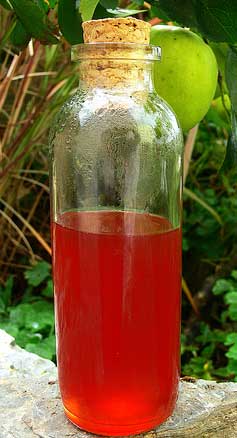Not Just A Pretty Face; Harvesting and Processing Rose Hips
Roses can do more than grace our landscapes and floral designs. Like its cousins the apple, pear, peach and cherry, roses produce a fruit. Rose Hips are a valuable source of vitamin C, containing as much as 20 times more vitamin C than oranges. They are also an excellent antioxidant. Rose Hips can be found in dried form in most health food stores, but why not gather your own? You’ll save money and you’ll know where they came from and the conditions in which they grew. Furthermore, you’ll be adding to your own self-sufficiency by locating and gathering a nutrient-dense food source to nourish yourself and your family. In many parts of the country, large hedges grow in great abundance producing attractive and fragrant pink and red flowers.
As the petals fade, a green hip, or hypanthium, begins to swell at each blossom’s base. They are fully red and ripe, and before frost tinges their foliage. Unlike their popular fruiting cousins, rose hips don’t have much flesh beneath their skins. Instead, they are filled with tiny seeds covered with silky hairs. The skin of the hip, often tasting like an apple, is where most of the food value and nutrition lies.
Nutritional Value of Rose Hips
All parts of the rose, and especially the hips, are storehouses of Vitamin C and other important nutrients. Comparing the nutritional content of oranges to rose hips and you will find that rose hips contain 25 percent more iron, 20 to 40 percent more Vitamin C (depending upon variety), 25 times the Vitamin A, and 28 percent more calcium. In addition, rose hips are a rich source of bioflavanoids, pectin, Vitamin E, selenium, manganese, and the B-complex vitamins. Rose hips also contain trace amounts of magnesium, potassium, sulfur and silicon.
Finding and Gathering Rose Hips
Wild roses grow throughout the world. There are literally thousands of varieties worldwide and most have been part of the human diet. In fact, it is difficult to find an area of the world or a temperature zone—barring parts of the Antarctic and the Sahara Desert—where wild roses don’t grow.
Although domestic roses also produce hips if they aren’t trimmed, the most abundant source of Vitamin C-rich rose hips is from wild hedgerows and thickets. Here hips can be gathered in vast quantities for cooking and storing. You’d have to grow a vast number of garden-variety roses to get a sufficient quantity of hips for use all year long. As most roses have thorns, gloves are helpful although not essential when gathering hips.
 |
Not every hip becomes ripe at the same time, so return visits will provide new ripe hips ready for harvest. The color of rose hips also varies, but in general, orange hips are not quite ripe, and deep red hips are overripe. Overripe hips are sweet, but have lost much of their vitamin C. They should be soft but not mushy. Break the stems off as you pick them. Rose hips will have the most nutritional value when used immediately after harvesting.
Preparing Rose Hips
Once you locate your rose hip source there still remains the question of turning them into something we deem not only edible, but tasty too.
For general processing of rose hip, spread the washed hips out and allow them to partially dry, where you can still remove the seeds, but they are no longer pulpy inside. When the skins begin to feel shriveled, you need to separate the seeds from the fruit. Cut the hip in half and scrape away the seeds. You may want to use something such as a chopstick or other blunt ended tool to help do this. After removing the seeds, allow the hips to dry completely before storing. Keep them in small, sealed plastic bags. They will keep indefinitely in the freezer or for several months in the refrigerator.
Rose hips prepared in the manner above can be used immediately to make tea.
Rose hips used for jellies don’t need to be seeded or scraped.
Uses For Rose Hips
Rose hips can be made into a variety of appetizing, healthy dishes. Turned into jelly, syrup, and wine, they make delightful gifts.
Crush 1 cup of dried rose hips and place into a covered container. Add one tsp. to 1 cup of boiling water. Brew for 3-5 minutes. Sweeten as desired.
You can also use 3-4 fresh rose hips that have been chopped. Add the boiling water and brew as usual. Some people like a very strong tea-you can brew up to 30 minutes and reheat the tea if necessary before sweetening.
Rose Hip Jam
1 pound prepared rose hips (about 4 quarts)
1 cup of water
Sugar
In a large pan, add the rose hips and water. Bring to a boil, then cover and simmer until very soft–about 20 minutes (add more water if necessary). Press or strain the mixture through a sieve to remove any seeds and to reduce large chunks of hips. Add one pound of sugar (about 3 1/2 cups) to one pound of pulp and simmer. Check the taste and add more sugar if desired. Cook until the mixture has thickened to jam-like consistency. Pour into sterilized jars and seal. This is good to eat when you have a sore throat.
Rose Hip Eye Treatment
Steep a cup of strong rose hip tea. You can make the tea with your own with rose hips or use store-bought. Do make sure it’s strong. Soak 2 cotton balls in the tea or use 2 tea bags, lie down and place over your eyes.
Rose Hip Marmalade
Use a glass or enamel pan for this recipe. Clean rose hips as described above for tea, and soak in cold water for two hours. Simmer in water for two hours. Strain and reserve liquid for jellies or other recipes. Measure the mash, and add 1 cup of brown sugar for each cup of mash. Boil down to a thick consistency. Pour into sterilized jars and seal.
Rose Hip Syrup
Syrup for pancakes, waffles, and vanilla ice cream is best made from freshly gathered rose hips. Rinse and pat dry the hips and place them in a saucepan. Barely cover with water and bring to a boil. Lower the heat and simmer until soft, about 10 to 15 minutes. Cool and strain the mixture, pressing the liquid off the hips gently with the back of a spoon, being careful not to break them open and release the seeds. If this happens, merely strain the seeds out. The resulting liquid may be frozen in batches for future use in soup or jelly, or turned into tasty syrup. The solids left over from straining can be fed to chickens or tossed onto the compost pile.
To make rose hip syrup, add one part honey to two parts of the heated, strained liquid. Stir to dissolve the honey and refrigerate. After refrigeration, the syrup will thicken slightly. Rose hip syrup will keep in the refrigerator for about two weeks. Reheat the syrup for use on pancakes and waffles. Use it warm or cold to top vanilla ice cream.
Heated syrup may be canned by pouring it into hot, sterile jars and processing in a boiling water bath for 15 minutes.
For a refreshing spring tonic punch, simmer rhubarb in rose hip syrup until soft. Strain and adjust sweetening as needed. Chill, and pour over ice for a refreshing, healthful libation to clear out the winter cobwebs. Add a sprig of fresh spearmint or lemon balm as garnish. Rose hip syrup may be used to sweeten and flavor herbal or black teas, as well.
Rose Hip Soup
A favorite dish of the Swedish is rose hip soup. They literally consume rose hips by the tons each year. To make approximately four servings you’ll need:
3 cups of freshly made or thawed unsweetened rose hip liquid
2 Tbsp. honey
2 Tbsp. lemon juice
2 tsp. corn starch
4 Tbsp. sour cream or yogurt as a garnish minced mint
In a saucepan, heat the liquid and add the honey and lemon juice. Remove ½ cup of the heated mixture. Into this, whisk the cornstarch until smooth. Add the cornstarch mixture back into the pan and bring to a high simmer, stirring, until the mixture bubbles and thickens. Add a dollop of sour cream or yogurt to each serving, topping with minced fresh mint, if desired.
Rose Hip Wine
If you make your own wine, the following recipe for rose hip wine is one of the healthiest and most lovely in color. You’ll need:
4 pounds of fresh rose hips
3 pounds of sugar
1 gallon boiling water
1 tsp. black tea
1 tsp. baker’s or wine yeast
Rinse and drain the hips. Place them in a primary fermenting vessel such as a clean food-grade plastic bucket that has a tight-fitting lid. Pour in one gallon of boiling water. Add the teaspoon of tea and all the sugar, stirring to dissolve the sugar. Let the mixture sit tightly covered for 24 hours. Add one teaspoon of baker’s or wine yeast and let the mixture ferment for seven days, covered, stirring once per day with a clean spoon.
Strain off the rose hips and pour the liquid into a one-gallon glass jug (an old wine jug works great) and fit with a fermentation lock or balloon. If you use a balloon, be sure to release the gases occasionally or it will burst. Place the jug in a warm spot until fermentation ceases. Siphon (rack) the liquid off of the yeast solids into a clean glass jug and refit with the fermentation lock or balloon.
Racking will usually reactivate fermentation for a short time. When fermentation ceases completely for several weeks, siphon the wine into clean wine bottles. Cork the bottles securely or use wine bottles with screw-on tops and store in a cool spot for six months or longer. There will usually be a glass or two of wine left after bottling. This you can enjoy right away.
Additional Research:
  |


Leave a Reply